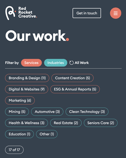Red Rocket Creative has always been a company of lifelong learners. In today's rapidly changing marketing landscape, continuous improvement must become our highest priority alongside daily tasks. Some recent changes heavily impact our daily work and push us to acquire new skills, and we want to share them with you.
We interviewed our team members about current trends and how they’ve affected the way they work. Here’s what we’ve got.
What’s New in Design and Branding?What’s New in Website Development?
What’s new in Project Management?
What’s New in Design and Branding?
1. Accessibility influences all aspects of design - from web design to branding and even print
The focus on making our designs accessible had the most significant impact on our work. This approach has influenced everything we create, including print materials. Now, we prioritize using colours that everyone can see and making sure that whatever we design is easy for people to use. It's all about constantly thinking about end users—whether it's the colours, fonts, or the overall experience.
 Using plugins in Figma, such as A11y, we can continuously check our designs comply with Accessibility standards. (Client CEC Mining Systems)
Using plugins in Figma, such as A11y, we can continuously check our designs comply with Accessibility standards. (Client CEC Mining Systems)
 Using high-contrast colour palettes and offering more tints allows us to create more accessible colour combinations. (Client CEC Mining Systems)
Using high-contrast colour palettes and offering more tints allows us to create more accessible colour combinations. (Client CEC Mining Systems)
“Accessibility isn't just a web concern—it's become the backbone of everything I design, from digital interfaces to printed materials.”
Courtney Bodkin, Senior graphic designer
2. New features in popular design tools strongly influence visual design trends
The rapid integration of new features in design applications like Photoshop and Illustrator has transformed visual design trends. These updates now enable designers to effortlessly create what was once complex and time-consuming. With just a few clicks, we can now modify images, generate vector illustrations, and create advanced effects, such as three-dimensional designs that once required specialized skills and time-consuming 3D rendering. This is how visual trends are born today.
We dedicate extra time to stay updated with these rapid changes and experiment with new features. It is a continuous process of adapting to the latest advancements and understanding how they can improve our work.

 An example of the new 3D rendering tools in Illustrator making the Inflatable 3D trend popular in the design world - here is how we applied it to our corporate client. (Client Wheaton Precious Metals)
An example of the new 3D rendering tools in Illustrator making the Inflatable 3D trend popular in the design world - here is how we applied it to our corporate client. (Client Wheaton Precious Metals)
-1.png?width=800&height=426&name=Forms%20(1)-1.png)
 Geometric shapes are a prominent design trend we're seeing today. By incorporating these contemporary elements into our clients campaigns and assets, we can infuse a sense of playfulness and modernity, enhancing our clients' brand presence while maintaining their timeless appeal. (Client Stratford Hall)
Geometric shapes are a prominent design trend we're seeing today. By incorporating these contemporary elements into our clients campaigns and assets, we can infuse a sense of playfulness and modernity, enhancing our clients' brand presence while maintaining their timeless appeal. (Client Stratford Hall)
“The rise of tools’ technical capabilities has democratized design, making what was once complex and time-consuming now accessible to everyone.”
Courtney Bodkin, Senior graphic designer
3. B2B brands are experimenting with their brand identities
Today's B2B brands are now expected to match the quality and experience of B2C brands. Being corporate no longer means being boring. Incorporating playfulness into our B2B projects is exciting, but we always consider the client's brand personality. Visuals and tone of voice still need to fit within the brand’s identity, so we need to be creative in how we inject freshness into our marketing materials.
“We are no longer just looking at competitors for inspiration; we are drawing from a broad spectrum of brands and design trends to keep our designs and websites fresh and innovative.”
Sangeet Anand, Director of digital strategy
4. AI simplifies research and boosts creativity
We primarily use AI tools for brainstorming, generating ideas for themes, copy, titles, or naming concepts and expanding on existing ideas. These tools help organize thoughts and research into structured formats. Traditional software like Photoshop and Illustrator are adopting AI to reduce repetitive tasks. Platforms like Adobe Stock are incorporating AI-generated images, providing more creative visuals for brainstorming and concept presentation, which is beneficial for clients with smaller budgets or limited access to certain imagery or locations.
While AI tools are powerful, they can't replace the critical eye of a seasoned designer. AI supports creativity, helping us refine and realize ideas, but they remain just that: tools. The spark of creativity still comes from us.
“As AI becomes more integrated into our tools, it opens doors to creative concepts we once only dreamed of, especially on a budget.”
Angela Dallin, Creative director
 AI-generated illustrations and images allow us to quickly create visuals for layouts or concepts.
AI-generated illustrations and images allow us to quickly create visuals for layouts or concepts.
5. Designers become true all-rounders
Today's accomplished designers must have a diverse skill set beyond graphic design, which now includes UI/UX, web design, and even research. The industry no longer favours specialization in just one area; instead, having diverse skills is essential to meet growing client demands and stay competitive. While digital mastery is necessary to remain relevant, graphic design skills are here to stay, particularly for print work. Blending these skills has become essential as these roles increasingly overlap.
“In today's design world, being multidisciplinary isn't just an advantage—it's a necessity, as the lines between UX, UI, and graphic design continue to blur.”
Josh Lee, Graphic designer
What’s New in Website Development?
1. Websites now feature more sophisticated designs, functionalities, and data handling
Website complexity has increased. Users expect B2B websites to be as engaging, user-friendly, and efficient as B2C sites. This results in intricate designs with many animations, numerous APIs and integrations with marketing or payment tools, and advanced security features.
“The web is always evolving, and that requires constant adaptation—it's less about trends and more about continuously improving the developer’s craft.”
Caroline Currie, Web developer
2. Websites continue to evolve from marketing tools to digital products
This shift is driven by websites now serving all parts of an organization. They are not only marketing tools anymore. Every part of an organization, from HR to investor relations to sustainability teams, wants its voice to be represented on the website. The challenge is keeping the site cohesive and user-focused while accommodating each team's needs. This requires a careful user experience strategy.
“Collaborative workshops and user research are crucial in website development, especially for B2B companies. Asking the right questions is essential for guiding stakeholders to consider the impact of their decisions on user experience.”
Sangeet Anand, Director of digital strategy
3. No-code solutions are on the rise
No-code solutions like Squarespace and Webflow allow individuals without coding skills to easily create functional websites. These platforms offer a quick and efficient way to build pages, serving as a solid foundation that can be further customized with code if needed. Although they may have limitations in managing complex content relationships and other advanced features, their ability to integrate elements like animations without any coding is a significant development. As these tools evolve, they’re becoming increasingly valuable assets for marketing teams.
What’s new in Project Management?
1. Automation and AI become essential as companies focus on efficiency and project teams become leaner
In today’s market, companies must prioritize efficiency. With smaller teams, effective communication and streamlined information flow are crucial. We often work with a few key stakeholders in large organizations, relying on technology to automate schedules and manage tasks. This approach helps us handle multiple projects simultaneously, keep everyone aligned, and deliver quality results despite tight deadlines and changing conditions.

“As our projects grow in complexity, our reliance on technology deepens, transforming how we gather, organize, and act on constantly changing information.”
Bernardo Perezverdia, Marketing project manager
2. Collaboration relies heavily on technology
Collaboration in workshops and meetings has evolved, requiring us to adapt. Platforms like Miro, Zoom, Slack, and Google Workspace have changed how we connect, but it’s clear that simply using these tools isn’t enough. The challenge is to go beyond the basics—experimenting with new collaboration formats and finding ways to use these platforms to make our sessions with clients more inclusive and engaging. By doing so, we create dynamic sessions where everyone’s input truly shapes the outcome.

3. Industry knowledge is the key to efficiency
A strong foundation in project management is essential, but nowadays, industry-specific knowledge is key to true effectiveness. While theoretical training and experience from other sectors provide valuable insights, they may not fully apply to the nuances of your particular field. Each domain requires adaptable, industry-specific processes. Flexibility and a deep understanding of the industry's unique demands are crucial for successful project execution.
“Industry-specific knowledge is the secret ingredient that turns a competent project manager into an exceptional one. The art lies in adapting processes to fit real-world scenarios, budgets, and time constraints.”
Yousra Salima Benjelloun, Digital project manager
Conclusion
At Red Rocket Creative, continuous learning and adaptation drive our success. As our industry evolves, we embrace new tools and strategies to stay ahead. From prioritizing accessibility in design to harnessing the power of AI in our workflows, we are constantly refining our approach to meet the growing demands of our clients. Our team's insights highlight the importance of flexibility, industry-specific knowledge, and a willingness to experiment with new technologies. By doing so, we not only keep our work fresh and innovative but also ensure that we deliver results that truly resonate with our clients' needs.
Perry Boeker
Principal & Marketing Strategist A results-driven creative thinker, Perry is a marketing management professional with a proven record of achievement in Strategic Planning, Team Leadership, and New Concepts Development.



.jpg)